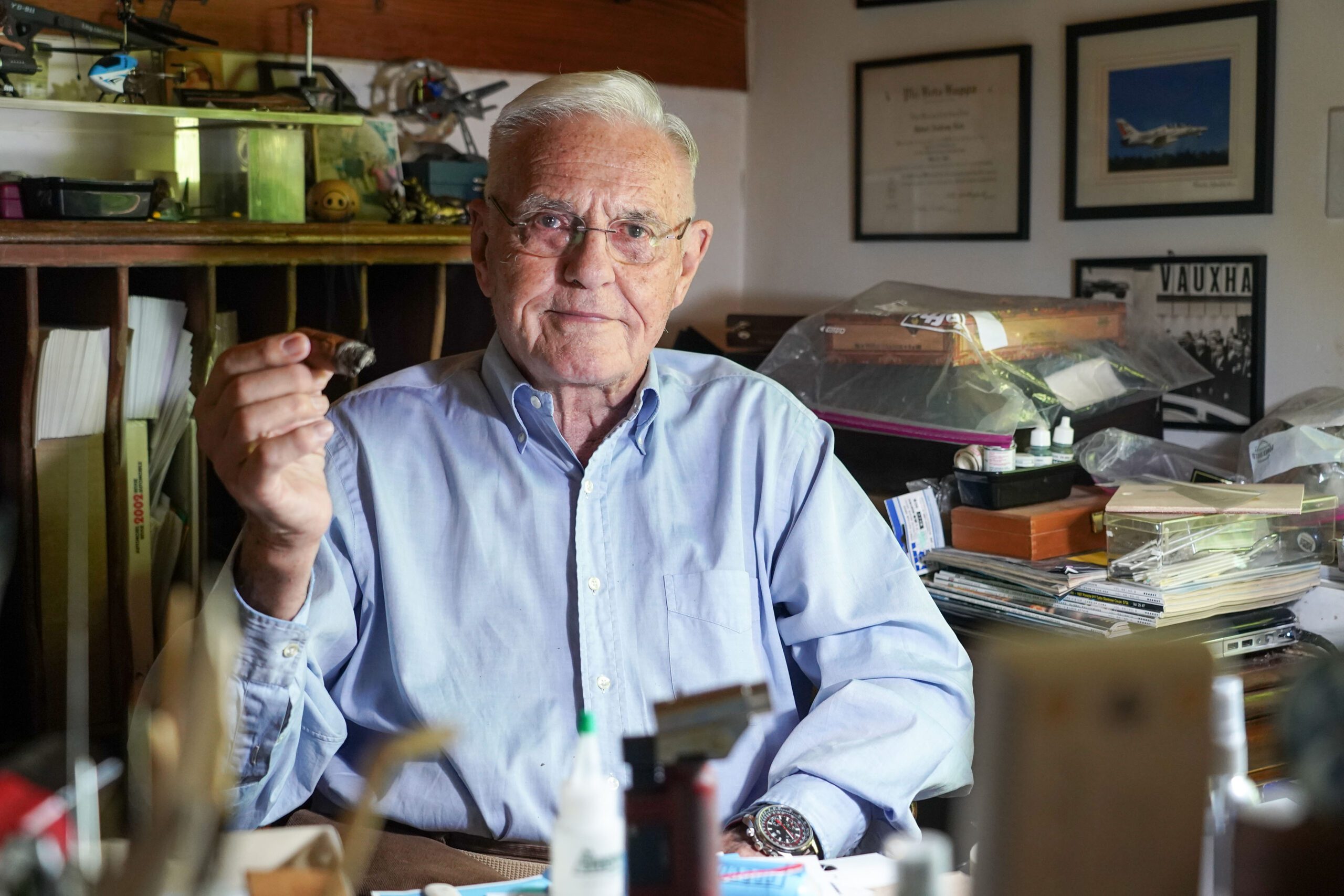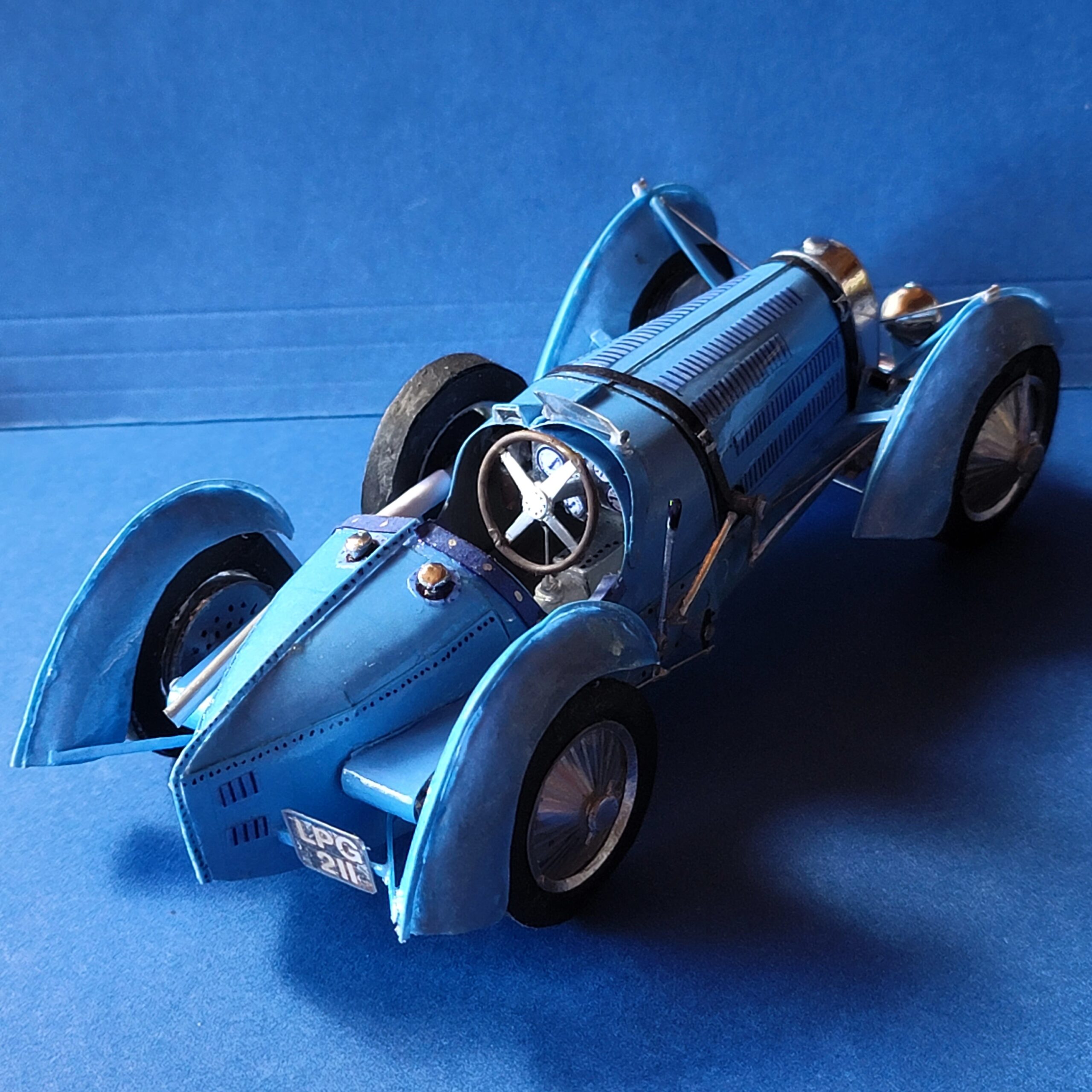
Bob Lutz photographed at his home outside Ann Arbor on May 16, 2024
Bob Lutz was born in Switzerland, but crossed the Atlantic six times by the time he was six. His father, a banker, was often assigned overseas. Then, in 1939, he was sent to Credit Suisse’s Wall Street office. “Obviously in ’41, we didn’t go back,” Lutz says. “So from ’41 to ’47, we were in the States.”
Living in Scarsdale, New York, he “festooned” his bedroom with “pre-printed, die-cut paper models of World War II airplanes, both ours and Japanese and German. You could punch them out and then bend them and then glue them together. My execution wasn’t very good, but my mother had to buy me book after book because I made ‘em all.”
He was equally captivated by automobiles. “At three, I could name almost every car on the road,” he told the British website The Intercooler last year. He modeled them, too, “out of sheet balsa wood [with] reinforcing strips on the outside. Paint them up properly, they’d actually look pretty good.”
Plenty of kids are fascinated with airplanes and cars, but few took it as far as Lutz: he flew fighter and attack jets in the U.S. Marine Corps and later, his own jets and helicopter.
He could afford them because for decades he was one of the most influential executives in the auto industry, shaping models that ranged from the first BMW 3 series and Dodge Viper to the Ford Explorer and Chevy Volt.
And now, after a succession of high-level jobs and dozens of distinctive vehicles, he’s once again making paper models.
No books this time—he starts with paper stock and images off the internet. He engineers each design—1:24 scale for cars, 1:33 for aircraft—then cuts the pieces out using a Swiss Army knife and precision scissors. He assembles them with shaping tools and special glues.
He’s told that when they’re displayed at Pasteiner’s, a car collectibles and hobby shop in Birmingham, customers sometimes assume they’re die-cast metal.
“Stories like that make me happy, because I’ve invented techniques that make paper do things and conform to shapes that normally paper does not want to do,” Lutz says.
“The reason I’m into car models now is because I don’t think anybody else builds scratch-built paper models of automobiles. I think I’m probably fairly unique.”
When Lutz was young, his father owned a “brand-new ’39 Mercury convertible,” and later a 1952 Aston Martin. But while “my dad liked cars,” he says, “he was not what I would call a car enthusiast. To him, nice cars were a reward that you got for yourself if you were successful. Which is the way I would say most rational people look at it.
“I was different. I was willing to live for the cars.”
His mother was a car enthusiast, he says, “not to the extent she could tell you the number of valves or [if one] had overhead cams or not,” but she “always had good looking cars, cars that were interesting to own,” including a Chrysler New Yorker convertible. And “she was an absolute expert driver.”
According to The Intercooler, Lutz was “turfed out of one prestigious Swiss school for ‘being too interested in the daughter of the biggest industrialist in town.’” His father made him promise to join the Marines, which taught him “duty, honor, commitment, courage, focus, self-sacrifice and dedication” – and, the author added, “not to be afraid to speak unwelcome truths to superiors.”
He served as a Marine aviator in the Pacific, then got a degree in production management (“nowadays they’d call it industrial engineering”) from UC Berkeley. He went on to earn an MBA—though “the MBA thinking never really took hold in my case.
“I’ve always wanted to do things that other people didn’t do,” he says, “and I’ve always had my own way of approaching business, especially the car business. And I’ve always been very intensely focused on what I think the consumer would like as opposed to following analytical models of which way the market is moving and how is this category going and how is that category going.”
He’s often said his “personal motto is ‘often wrong but never in doubt.’ But it’s not really never in doubt,” he says. “It’s seldom in doubt. If you look at a person like Elon Musk, he’s never in doubt. He never questions himself. And he doesn’t listen to others. This is probably why I never achieved what Elon Musk did … I always was aware of my own shortcomings and I always tried to remember that I wasn’t infallible.
“I would listen to my subordinates. Sometimes I was, admittedly, hard to convince that I was wrong. But when I was, I had no trouble admitting it, and we’d go in a different direction.”
An expert driver with a designer’s eye, Lutz says he’s “always believed that you have to have the creative impulse and the desire to create. That’s gotta come first. Then you subject it to analysis to make sure you’re not barking up the wrong tree, and then you execute it.”
That mindset helped him climb one corporate ladder after another: chair of GM Europe, global head of sales at BMW, head of international operations for Ford, president of Chrysler, CEO of Exide Technologies, and finally back to GM as vice chairman.
By his own account, his bluntness about what he saw as subpar products and poor decisions contributed to the career churn. In his three books about the car business—Guts, Car Guys vs. Bean Counters, and Icons and Idiots—he recalls offending everyone from a member of BMW’s Quandt family to Chrysler chairman Lee Iacocca—who vetoed him as a successor.
“If I had been politically a little more astute and kept my mouth shut at times when I should have kept it shut,” he says, “I might have become a CEO of some automobile company as opposed to an eternal number two who actually got things done.
“I can talk myself into regretting aspects of my life, but not severely. I might tell myself I might have done a better job in my personal life, so nothing’s ideal, but all in all I think I look back on life and it came out the way I had hoped. For instance, if I had become CEO of Chrysler, I would have had a nice career. I would have had a lot of money. But then later, I could not have become vice chairman of General Motors. So I think everything kind of worked out for the best.”
After three divorces, he married the former Terri Smith in 2013. “She’s just a wonderful woman. She’s sixty-two now, so almost exactly thirty years younger than I am.” They have two pet pigs, a dog, and three cats.
He has four daughters, “all from my first wife, now deceased—a Swiss girl who became an American citizen.” Jacqueline, in California, “likes interesting cars and her husband, my son-in-law, is a great car enthusiast, and has quite a few,” Lutz says. The next, Carolyn, lives in Zürich and London and works for an executive search firm. She “was a captain in the Marine Corps,” he says, but was denied the chance to become an aviator—“sadly at the time that was not open to women.” He says she’s a “phenomenally good” driver and “a brilliant motorcyclist who owns several race bikes and regularly competes on European tracks.”
Katherine, in Germany, once owned with a boyfriend a business that “would go to the U.S., buy old Corvettes at auction, take them to Germany, fix them up, and then sell them for a very substantial profit. She doesn’t do that anymore, but she’s had a lifelong interest in cars and styling.” The youngest, Alex, is “a well-employed housewife in the Chicago area … She’s one of the most successful women I’ve ever met at balancing marriage, motherhood, and a career, all at the same time.” They visit often—“at eighty miles an hour, they’re like three hours and forty minutes from our house”—and her daughter, Mia, is a student at the U-M. When school’s in session, she often spends Sundays at his farm west of town.
After a lifetime of moving fast, old age is finally slowing Lutz down. “I no longer ride [motor] bikes,” he says, and he gave up flying at eighty-eight. He kept a house in Switzerland until three years ago, but now, “I don’t like to travel to Europe anymore. I don’t want to travel to the Far East.
“I’m not wealthy enough to afford my own Gulfstream, in which case I’d probably continue to fly. But my big phobia is airports, standing in line, and I don’t see myself doing that anymore.
“So I’ve kind of restricted my travel. Your focus goes from kind of a macrofocus to kind of a microfocus.”

Lutz’s Bugatti Type 59 is seven inches long and constructed entirely of paper.
That’s where the models come in. How does he choose what to make?
“Some of them are aspirational,” he says. “Some are cars I would have loved to own, like the Bugatti Type 35 or the Bugatti Type 59. Some of them have become aspirational through building the model …
“I’ve always been a very creative person. I like to create things. And in the car business, I was able to create full scale, and I no longer have that opportunity. So I’m creating at a 1:24 scale [but] with the same passion, the same drive for innovation and continuous improvement.
“I always looked at life as something to be enjoyed. And achieving things of course was always part of enjoyment. I was trained to achieve things. I don’t think you can have any decent self-esteem if you don’t believe you’ve earned it. I believe I have. I can look back at the things I’ve done and tell myself all in all, an A-.
“There’s something about getting old in good health that they never tell you. You stop fretting and worrying about things that caused mental anguish and stress twenty or thirty or forty years earlier in your life. You find yourself in a very deep calm, stress-free, genuinely happy.
“If somebody said, ‘Would you like to be eighty again?’ Oh yeah, sure. ‘How about seventy?’ Oh yeah, even better.
“But when you look at it, this is, if not the happiest, one of the happiest periods of my life. Everything seems to be in balance.
“Nearing the end of my life, one could say that 7-inch paper cars are a sad comedown from leading billion-dollar real production car programs,” he emails. “Maybe. But the thought-process, the learning, the continuous improvement, the dissatisfaction with flaws few besides me notice, and the admiration and respect one gets from the finished product are much the same. So, trivial in the grand scheme of things, but for me it’s anything but!”



I was always proud to work at Chrysler in the Lutz era. He helped to create outspoken products that were fun to develop. I wish he would have gotten the top spot as well.
I was the Design manager for the Explorer program when Mr. Lutz became VP of Ford Trucks. The design was pretty well finalized at that time and I got word he wanted to see a version of the Explorer as it might have been as a European model. I never got the chance to show the design proposal to him as he soon left Ford for Chrysler. Sorry Mr. Lutz – I finally threw the sketch away years ago! I do love his paper cars and airplanes at Pasteiner’s … just incredible!
Well, Mr. Lutz, I was first introduced to you in the book “Taken for a Ride.” While you weren’t the main character in the book I found the descriptions of you and your activities to be fascinating. Then, yesterday I stumbled upon a podcast interview with you on You-Tube — I believe done about two years ago. From that, I decided I really needed to read “Icons & Idiots” (which I’ve just ordered from Amazon and am looking forward to reading). While waiting for the book I decided to get some more “background” on you by going to Wikipedia. While on the way to Wikipedia I stumbled upon the present informative magazine article in the Ann Arbor Observer, which has prompted this reply.
Having grown up in Birmingham (MI) in the 1950s and early 60s, I can somewhat relate to your passion for cars. I can recall how much I wished I had a Corvette to do my “woodwarding” with, instead of one of the family’s station wagons.
Finally, I’m heartened to learn that at 90 years old you’re still mentally acute and productive. I just turned 80, and am still busy pursuing my hobby-vocation of book writing and publishing. If when I reach 90 I’m as cognizant and productive as you are, I will consider myself blessed. That’s it — I hope you’re having a great summer.
I worked for Bob for a year or so at Exide Technologies he was a pleasure to work for who coached his direct reports instead of dictating. Exide as a battery manufacturing company never caught Bob’s passion for building cars as he retuned to GM where he began his career.
He did me the biggest favor of letting me go to start my life long dream of starting and running my own company.